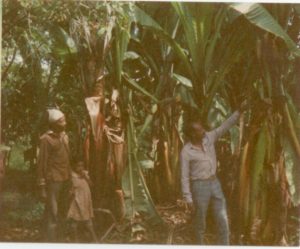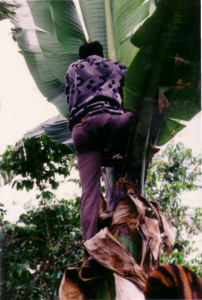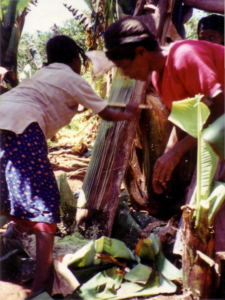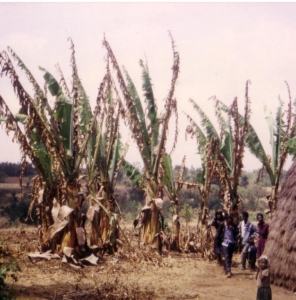Farmers’ Indigenous knowledge: Cultivation, Utilization and classification, of Enset in North Omo (Ethiopia)
Kefale Alemu
Introduction
Enset (Ensete ventricosum) is a perennial herbaceous root crop with long broad leaves and bulky pseudostem. This multi-purpose root crop is widely grown in the central, south and Southeastern part of Ethiopia for its food, forage, fiber, and to some extent for medicinal uses. The corm and the leaf sheathes are the main sources of human and animal feed
Sizes of Enset plants vary depending upon management, the Enset type/cultivar, soil type and fertility, amount and distribution of rainfall, and altitude of the area. It reaches up to 10.300m in height and the girth at the fattest point can be up to 4m (Kefale A and Sandford S. 1991).

Albeit the crop is very important there is inadequate information regarding the existing production systems and distribution of different enset types across different agro-ecological zones. Moreover, the role of indigenous knowledge in cultivation, management, utilization and classification is not well studied. At present researchers’ knowledge is limited probably because of two reasons. Firstly it is domesticated and cultivated as a crop only in Ethiopia. Secondly, little research is done because it takes long time (from 3 to 10 even more years) for plants to mature so it is not as easy to carry out experiments in various agro-ecological zones and various soil types as another shorter season crops.
However, farmers have amazing knowledg of Enset, which has been accumulated over many generations. As the first cultivators and experts, their knowledge will have profound importance for both the recent and the future sustainable use and conservation. As Bezuneh mentioned (1993), during the last several decades, enset cultivation has evolved as one of the most stable and sustainable agricultural development systems, because the system has been efficient in building and sustaining the fertility of the soil. It seems that it would be valuable to learn from the centuries of farmers’ practical experience and benefit from their understanding. This will not only help to improve the enset dependant farmers’ livelihoods and their immediate needs but also have implications for better utilization and future conservation of this promising, multipurpose and very high yielding crop.
Based on my fieldwork experience with the Farmers’ Research Project of FARM Africa and other relevant literature this paper discusses the indigenous technical knowledge used by Ethiopia farmers in particular in cultivation, classification and utilization of enset.
Cultivation and Farmer Enset Interactions/ Relations
Farmers-enset interaction and relations are found to be very interesting in enset cultured areas. This reflects the indigenous knowledge of the crop, their values, folklore and culture associated with the plant. In enset growing areas traditional houses are constructed (thatched) using its dried mid-rib and pseudostem leaf sheaths. Enset is a food for humans and feed for animals. It conserves soil and moisture in and around the enset plantations, vegetables and short annual crops enjoy the always-available moisture because of its bread leaf canopy coverage. It is ornamental, a windbreak that protects the house from strong wind, giving pleasure to the household and to visitors. A farmer with large enset plantation and many mature (big) enset plants can immediately be recognized by outsiders as a rich and respected man. Just by looking the farmer’s house, his enset plantation and the vegetables in the garden one can tell whether he is food self-sufficient or not. A household’s status and wealth is often assessed in terms of the number and age of enset plants, and also in terms of the size of the plants at his homestead.
According to Wolaita farmers in the past (some say even today) guests prefer to go in to houses where large enset plantation with many matured enset plants are available. Therefore, as Balick and Cox (1996) emphasized, the study of the interaction of plants, and people, including the influence of plants on human culture, is the focus of the interdisciplinary field of ethno botany. Bezuneh (1993) has also suggested that in addition to regular agronomic research themes, the central focus should be the homestead environment (family decision, culture, etc.) that galvanizes enset culture and agriculture.
Enset cultivation requires careful nurturing. There is a very intimate relationship between the whole household and the enset plant in the homesteads. On his study on the Ari enset growing areas of southern Ethiopia, Shigeta (1990) mentioned farmers’ intimacy with enset through daily associations with and their proximity to enset plants. They often know not only the vernacular name but also the life history of individual enset plants. That is why in most cases it grows near the farmer’s’ house. Since farmers live near their enset gardens manure and house refuse can be applied on daily basis and plants can be protected from wild and domestic animals. If a diseased enset plant appears in the plantation the household members will immediately uproot and throw it somewhere far from the plantations (so as to protect the healthy plants).
This proximity to the house is also convenient for the day to day management, harvesting, processing, for every day preparation of food either from the corm or from the already fermented (kocho) product. As Kefale, Sandford and Kassa (1993) mentioned, women harvest and process enset in-situ in the gardens. Harvesting is usually undertaken by small working parties formed by group of female friends and close relatives. Even very small children with their parents or alone visit the homestead frequently i.e. when they harvest their daily food either from the enset or from other garden crops. They enter the plantation to take the broad leaves to make bread or to serve their daily food etc.
Men prepare the land, split and bury corms for vegetative propagation of suckers, plant and replant enset plants of different ages, so they usually decide which area of land is to be used as an enset plantation. They will also have a strong say as to which varieties are to be planted, although women do offer their opinion (Sandford and Kassa. 1993). The corm is split into two or four parts and buried in the ground at about a 30 degrees angle. The management of the suckers is different from the management of other enset plants that are found at different growing stage. When splitting and burying the corm they not only consider the season (usually dry season) but also the movement of the moon (chegena). Farmers strictly believe that the movement of the moon not only affects enset harvesting and propagation but also other crops and plant species.
During planting the male wants to plant the male enset and the female wants to plant the female enset plants. The female farmer makes the decisions and is responsible during the harvest as she has the strongest interest in getting something to be harvested and cooked. On the other hand the male farmer does not want enset plants to be harvested at their earlier (immature stage), even if he knows that the product will be consumed by themselves and their families. Fearing the long-term effect on the age and sex structure of the plantation and the consequence of food shortage, they will not always be comfortable during the harvesting of immature enset plants.
The males prefer male enset plants because there is less temptation for the women to harvest the plant before maturity for the sake of eating the delicious boiled corm of the female plant (Kefale and Sandford 1991). However, farmers always (except the poorest) combine and, row various types of male and female enset plants. On the other hand it was disclosed by the farmers that even though the corm of the male enset plant is sour and unpalatable, during critical food shortage times it could be uprooted and consumed at its earlier stage.
Farmers’ store an enset products (e.g. Bula) by wrapping them and by covering them in deep pits. The use of indigenous knowledge in propagation, transplanting, inter-cropping, harvesting/processing, protection from pests and diseases are valuable. In general it seems that for the small-scale, resource poor farmers and crops such as enset the utilization of the existing ITK or its further development considering the local situation have tremendous importance and implications. Farmers cannot travel long distances and buy expensive exotic technologies for their small patches of farms. One of the good examples is the trap invented and used by most of the North Omo farmers (Aressawum 1993) against mole rate, which is one of the notorious pests of enset and other root crop. Even though there is a need to upgrade it, the technology is still appropriate in the area and has an important role in controlling the mole rates.
 |
 |
 |
 |
